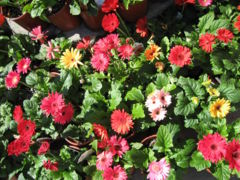Gerbera: Difference between revisions
template, RHS, pic |
|||
| Line 143: | Line 143: | ||
==References== | ==References== | ||
*[[Standard Cyclopedia of Horticulture]], by L. H. Bailey, MacMillan Co., 1963 | <!--- *[[Standard Cyclopedia of Horticulture]], by L. H. Bailey, MacMillan Co., 1963 --> | ||
<!--- xxxxx *Flora: The Gardener's Bible, by Sean Hogan. Global Book Publishing, 2003. ISBN 0881925381 --> | <!--- xxxxx *Flora: The Gardener's Bible, by Sean Hogan. Global Book Publishing, 2003. ISBN 0881925381 --> | ||
<!--- xxxxx *American Horticultural Society: A-Z Encyclopedia of Garden Plants, by Christopher Brickell, Judith D. Zuk. 1996. ISBN 0789419432 --> | <!--- xxxxx *American Horticultural Society: A-Z Encyclopedia of Garden Plants, by Christopher Brickell, Judith D. Zuk. 1996. ISBN 0789419432 --> | ||
Revision as of 16:30, 1 June 2009
Gerbera {{{latin_name}}}
|
Gerbera, Transvaal daisy, Barberton Daisy
| ||||||||||||||||||||||||||||||||||||||||
|---|---|---|---|---|---|---|---|---|---|---|---|---|---|---|---|---|---|---|---|---|---|---|---|---|---|---|---|---|---|---|---|---|---|---|---|---|---|---|---|---|---|

|
|
| |||||||||||||||||||||||||||||||||||||||
| |||||||||||||||||||||||||||||||||||||||||
Hairy, stemless herbs. Perennials which can be treated like annualsRH. Leaves may spread or come up from a basal rosette, are entire to dentate (or rarely pinnately lobed), petiolate, and hairy underneathRH.
Cultivation
Most common are the G. jamesonii hybrids, with extremely long-lasting cut flowersRH. The flowers come in a wide range of pastel and basic bright colors. In frost-free areas they overwinter safely outdoorsRH. In cold-winter areas, keep at 5-7°C (40-45°F) and keep just moistRH.
Tip: Scald tip of stem when cutting flowers for vase to make them last longerRH.
Propagation
Plants may be divided in the springRH. Seed.
Pests and diseases
- Do you have pest and disease info on this plant? Edit this section!
Species
About 40 speciesRH, includingwp:
- Gerbera aberdarica
- Gerbera abyssinica
- Gerbera ambigua
- Gerbera anandria : Ghostly Daisy
- Gerbera anandria var. anandria
- Gerbera anandria var. densiloba
- Gerbera anandria var. integripetala
- Gerberia anadria var. bonatiana
- Gerbera aspleniifolia
- Gerbera aurantiaca : Hilton Daisy
- Gerbera bojeri
- Gerbera bonatiana
- Gerbera bracteata
- Gerbera brevipes
- Gerbera burchellii
- Gerbera burmanni
- Gerbera candollei
- Gerbera cavaleriei
- Gerbera chilensis
- Gerbera cineraria
- Gerbera connata
- Gerbera conrathii
- Gerbera cordata
- Gerbera coronopifolia
- Gerbera curvisquama
- Gerbera delavayi
- Gerbera discolor
- Gerbera diversifolia
- Gerbera elegans
- Gerbera elliptica
- Gerbera emirnensis
- Gerbera ferruginea
- Gerbera flava
- Gerbera galpinii
- Gerbera glandulosa
- Gerbera henryi
- Gerbera hieracioides
- Gerbera hirsuta
- Gerbera hypochaeridoides
- Gerbera integralis
- Gerbera integripetala
- Gerbera jamesonii : Barberton Daisy, Gerbera Daisy, Transvaal Daisy
- Gerbera knorringiana
- Gerbera kokanica
- Gerbera kraussii
- Gerbera kunzeana
- Gerbera lacei
- Gerbera lagascae
- Gerbera lanuginosa
- Gerbera lasiopus
- Gerbera latiligulata
- Gerbera leandrii
- Gerbera leiocarpa
- Gerbera leucothrix
- Gerbera lijiangensis
- Gerbera lynchii
- Gerbera macrocephala
- Gerbera nepalensis
- Gerbera nervosa
- Gerbera nivea
- Gerbera parva
- Gerbera peregrina
- Gerbera perrieri
- Gerbera petasitifolia
- Gerbera piloselloides
- Gerbera plantaginea
- Gerbera plicata
- Gerbera podophylla
- Gerbera pterodonta
- Gerbera pulvinata
- Gerbera pumila
- Gerbera randii
- Gerbera raphanifolia
- Gerbera ruficoma
- Gerbera saxatilis
- Gerbera semifloscularis
- Gerbera serotina
- Gerbera speciosa
- Gerbera tanantii
- Gerbera tomentosa
- Gerbera tuberosa
- Gerbera uncinata
- Gerbera viridifolia
- Gerbera welwitschii
- Gerbera wrightii
Gallery
If you have a photo of this plant, please upload it! Plus, there may be other photos available for you to add.
-
photo 1
-
photo 2
-
photo 3
References
External links
- w:Gerbera. Some of the material on this page may be from Wikipedia, under the Creative Commons license.
- Gerbera QR Code (Size 50, 100, 200, 500)
